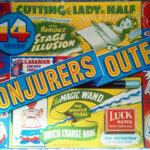A key element of enquiry for me when working practically in bizarre magick was my role in the creation of my magician persona and the performative world I constructed around that persona, this is discussed primarily in Taylor (2014, 2020). Magician-only literature on bizarre magick, aside from providing the bizarre magician with a large number of effects, presents a great deal of discourse as to what a bizarre magician should be and how that role might be played.
I began my own journey with an examination of the more general notion of the performance magician and how they might classify their practice. This is often attempted through formulating an occurrence classification of effects, that is, an analysis of effects based on the thing that appears to be happening in performance. For example, Daniel Fitzkee in The Trick Brain (1944) developed a basic list of nineteen effects, and much later Lamont and Wiseman (2005, pp. 3–7) provided a useful simplification of this effect classification. I found that, while these classification systems were helpful at the level of the effect, that is, what the audience sees, the systems tend to focus on the performance of magic at the functional level of the trick, rather than as an effect based on a particular theme or act of performance. When focussing on the mechanical in this way the performance of magic becomes a non-complex form, with the emphasis on tricks rather than embracing a holistic performance practice. Robert Neale in The Magic Mirror (Neale & Parr, 2002) presents a more thorough analysis, and through using Fitzkee’s classification as a foundation, Neale develops an occurrence classification that is useful for beginning to unpick not only the classification of effects but also the experience of that effect. Neale refers to this as the effect’s ‘symbolic’ concerns. For Neale, the three basic symbolic concerns are; Being, Doing and Relating. Each of these areas have three sub-concerns which are in turn linked back to Fitzkee’s nineteen basic effects (Neale & Parr, 2002, pp. 68–71).
Previously, and partly as a response to their own practice in bizarre magick, Eugene Burger and Robert Neale developed a model for the magician that considered the notion of ‘many magics’ (Burger & Neale, 1995). Burger and Neale suggested a movement away from classification by occurrence to a broader more considered overview as to what magic could be. They proposed five categories of magic; primary, secondary, reduced, restored and reflective. In these practical approaches Neale sees primary magic as ‘life magic’, which is the nearest thing to ‘magical thinking’ (Burger & Neale, 1995, p. 175),and is the ‘invisible magic in our lives’ (Burger & Neale, 1995, p. 179). According to Neale, the audience’s response to primary magic is the secondary magic of ritual and stage. Ritual being a response based on belief and stage simply being the performance of magic. The former response accepts magic as real, the latter response asks ‘what if magical thinking worked?’ (Burger & Neale, 1995, p. 179). In the next category, reduced magics, we see magic without belief, that is, performance magic presented purely to deceive or distract; and restored magics which is magic that relates to our humanistic concerns. The final category, reflexive magic, is a little more complex as it is ‘magic about magic’, that is, ‘magic that refers to itself’, defined by Neale as ‘trickster magic’.
In an early draft of this classification, Neale listed examples such as ‘Gospel Magic’ and ‘Bizarre Magick’ as being restored magic (Burger & Neale, 1995, p. 184). Bizarre magick finding a position such as this, would suggest that the practice had succeeded in some way as a form and that it could be used by magicians to explore and create ‘secondary worlds’ where ‘miracles are common’, both of which were called for by Tony Raven in his 1976 essay for Magick magazine ‘On the Presentation of Bizarre Magick’ (Raven, 1976).
Larry Hass in his article ‘Life Magic and Staged Magic: A Hidden Intertwining’ (2008) developed the work of Burger and Neale further, by making a separation between what he termed as ‘life’ magic and ‘staged’ magic. Although he does not quite refer to stage magic in the same way as Neale, Hass signals the importance of ‘mystery’ in the debate and warns us not to insist ‘on a false binary that divides magic from the things that really matter’ (Hass, 2008, p. 28), and that ‘people are magicians in their daily lives’ (Hass, 2008, p. 16). This re-evaluation of the role of magic and the magician, again coming out of the work the Mystery School, comes full circle in suggesting that there can be a blurring between the real and the performed. The key for me while exploring the performance of bizarre magick, was how this might map to my approach to being a magician and how an audience might then experience this magick.
Burger, E., & Neale, R. E. (1995). Magic & Meaning (1st ed.). Hermetic Press.
Fitzkee, D. (1944). The Trick Brain. Saint Raphael House.
Hass, L. (2008). Life Magic and Staged Magic: A Hidden Intertwining. In Francesca. Coppa, Lawrence. Hass, & J. Peck (Eds.), Performing magic on the western stage: From the eighteenth century to the present. Palgrave Macmillan.
Lamont, P., & Wiseman, R. (2005). Magic in Theory: An introduction to the theoretical and psychological elements of conjuring. University of Hertfordshire Press.
Neale, R. E., & Parr, David. (2002). The Magic Mirror: Reflections on the nature and relevance of magic (1st ed.). Hermetic Press; WorldCat.org.
Raven, A. (1976). On The Presentation of Bizarre Magick. Magick, 145, 725–726.
Taylor, N. (2014). Out of Tricks. In T. Landman (Ed.), The Magiculum (pp. 101–111). EyeCorner Press.
Taylor, N. (2020). Identity and Persona. In T. Landman (Ed.), The Magiculum II (pp. 58–63). Lulu Press Inc.

Comments by Nik Taylor